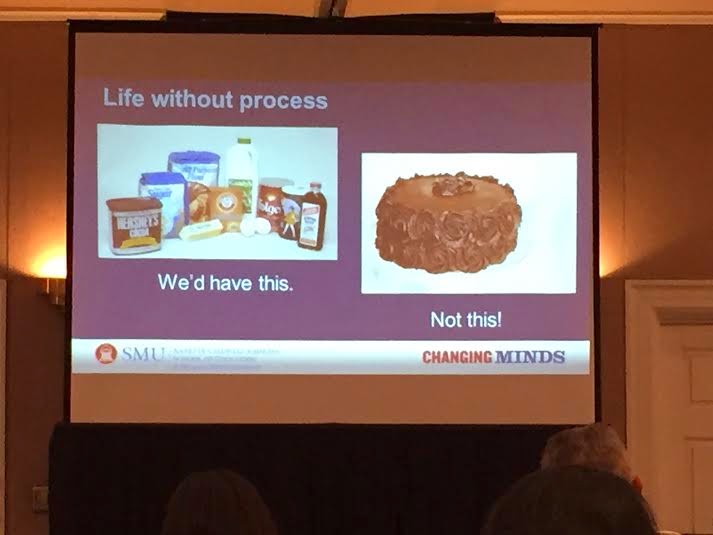The RME Conference
This year’s movement of the TEKS from
upper levels to lower, and vice versa, has left more teachers confused about
what is new, what is staying, and what is just being modified. Last summer,
several seminars were offered in Dallas ISD to better prepare teachers for
these challenging movements and to expand on the reasons for such movements.
The problem I found, however, was that most teachers were focusing on each individual
concept that was moving up or down or simply disappearing, rather than seeing
the whole picture. And while the movement of the process standards from the
very end to the very beginning were mentioned, teachers did not seem to pay
much attention to it. It wasn’t until I attended the Southern Methodist
University Research in Mathematics Conference that I finally understood the
importance of those standards and the reason why they were moved to the front.
This year’s RME’s Research-to-Practice
conference was focused on the Process
Standards part of the TEKS, which are the very first TEKS in every grade level.
The initial event had a panel of people from the Texas Education Agency, a
Baylor University professor, and a Chief Engineer. Their purpose was to show a
world view of the process standards, why they important, and how they are
incorporated in the real world.
The conference emphasized on all those essential pieces that
make lessons more effective and meaningful and how the process standards are
incorporated in those lessons. It was a reminder that the process standards are
what help our students learn and demonstrate their learning, by making better
sense of each TEKS they are introduced to. The best visual I can take from this
conference is the picture presented by Dr. David Chard. It was a picture
showing the ingredients to make a chocolate cake on one side and the finished
cake on the other side. This image showed the difference between teaching the
TEKS in isolation and teaching the TEKS with the process standards in mind.
In the breakout session “Mathematical Problem Solving in
Real World Situations,” Dr. Candace Walkington, an assistant professor at SMU,
discussed the importance of personalized learning. Personalized learning was
explained as instruction that is tailored to the specific interests of
different learners. This means adapting your instruction to the interests of
your students to allow them to create deeper and more meaningful connections
between what they’re learning and their everyday lives.
Dr. Walkington gave several examples of this, such as the middle school girl uninterested in mathematics but very knowledgeable of how Instagram works without realizing the mathematics behind it, and the student interested in creating short films with Legos and his understanding of how the frames per second impact the quality of the movements in the film. A lot of times teaches to improvise and create problems on the spot because they notice the students are particularly interested in something they mentioned. However, actually planning a lesson with prior understanding of the students’ interested and connecting them to the TEKS being taught is a better approach to personalize learning.
My approach to personalized learning was present on a poster
I created displaying an activity they did in class that was designed to address
the process standards as well as the TEKS being taught during that time. The
poster was about scale drawings. This concept basically gave a real world
application to other concepts such as similarity, proportion, scale factor and
conversion. The process standards were everywhere. When the students worked on
this activity, they were able to demonstrate their understanding of each of
those TEKS, while learning a new one through discovery. They were able to apply
their prior knowledge of relevant TEKS, develop a plan for this project, and
communicate their ideas and justify their methods during their presentation.
Teachers can better incorporate the process standards by
understanding what each of them mean, but most importantly, how they relate to
the rest of the TEKS. I believe teachers need to understand their importance
and the reason why they are an essential part of our curriculum. There are many
resources available for teachers. One of them is obviously the Research in
Mathematics Education Conference, where you can learn so much not only from
experts but also from all the educators who attend. I highly recommend exploring
discovery learning. This form of teaching gives plenty of room for teachers to
emphasize on the process standards. Another way to incorporate the process
standards is by collaborating with other teachers who are already successful in
this area. Sometimes teachers simply don’t know where to start, so asking those
successful teachers in your school might help.
Additional resources for teachers are also available on the
SMU RME website.
Resources
SMU RME
Resources from “Mathematical Problem Solving in Real World
Situations”
Dan Meyer’s 3-Act Math Activities
Spark 101 Mathematics
Model-Eliciting Activities
NRICH Complex Tasks http://nrich.maths.org/8517
The Art of Mathematics
NCTM Illuminations
NextLesson







No comments:
Post a Comment